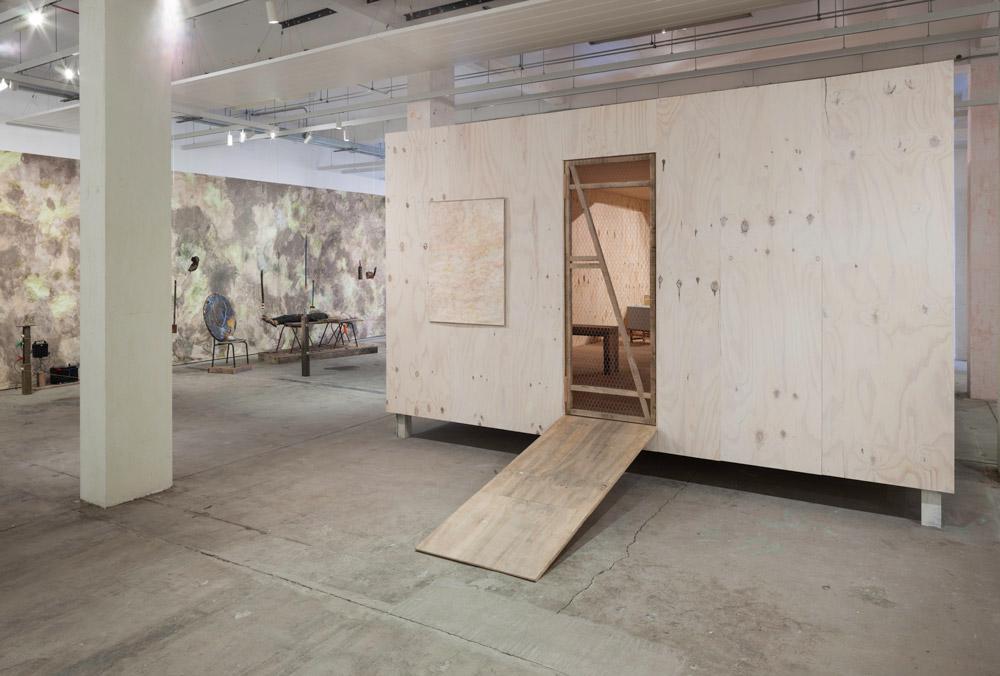In “Blocked Arch, Deferred Ceremony, Dawn Chorus. Tra-diddle-da. Like a Fly in Slow Suspense.” at Glasgow Sculpture Studios, Vancouver’s Gareth Moore showcases the results of a three-month residency as part of this year’s Glasgow International.
For the exhibition, Moore has, characteristically, used his immediate surroundings as a site for exploration—in this case, the Forth and Clyde Canal, an area currently undergoing a massive regeneration. Moore has collected and combined detritus from this area, including a piece of greenheart wood dredged from the canal after 150 years of being submerged there; clay from local clay pits; old tin cans; found plastic; nails; whiskey bottles; and clothing.
Upon arrival, one finds the main entrance of the studios bricked up; this forces the viewer in through a smaller side entrance in a manner that radically alters the flow of things. This gesture also brings the entrance closer to the canal, literally closing the distance between the objects inside and the landscape in which they were sourced.
The exhibition is divided into three parts which could also be described, despite their atemporality, as acts. The idea of time is important in this exhibition, even if its presence is only noted, in some ways, in its absence. Each work seems to imply a durational component while at least partially refusing to embody it.
Inside, the viewer encounters several strange ceremonies—or perhaps dioramas of strange ceremonies, events waiting to be performed. All are typically enigmatic and composed with Moore’s wry humour.
In Deferred Ceremony, an obscure effigy lies amidst instruments made from canal-culled debris, awaiting who knows what fate. On the opposite side of the gallery, a table of funeral vessels composed tin cans, paper bags and other materials are encased with unfired-clay faces. The exact nature of ceremony at hand remains unclear, but a proximity of fact and fiction, as well as of mythology and everyday life, seem to form the root of this work.
In the centre of the space sits a wooden hutch. Decidedly different in appearance from Moore’s found-object constructions, this hutch looks newly made and painted. Inside, it contains a “dawn chorus” of sorts. Upon first encounter, the chorus appears to be made up of small wooden boxes of varying sizes, shapes, and colours, but throughout the exhibition various domestic animals—including guinea pigs, a mouse, rats, dogs and other animals—actually spend time in these customized boxes. Their sounds while in the boxes are recorded, and a related record will be produced after the exhibition.
In the rear corner of the hutch sits a pile of dried pet food and a bench for viewers—viewers awaiting a performance that may occur at, or last for, any length of time “quite a few minutes, a number of hours, several days and some weeks, in accordance with the perceived human understanding of animal time,” an exhibition text indicates. I prefer thinking that Moore is calling the boxes themselves “animals” rather than actually making good on any claims to performance.
This process of waiting for the hutch’s “dawn chorus” performance—whether real or unreal—returns one to the noting of time and the way it operates in this exhibition. A strange temporality is indicated through titles, texts and expectations: ceremonies are deferred, rituals are left incomplete, items are suspended or unused, performances are sporadic and (often, perhaps) unheard. Duration itself seems to be in question. If time is, as Foucault insists, at the very heart of discipline, creating a regimented system of docile, productive bodies, Moore’s exhibition is its antithesis. Instead, Moore undermines cultural tendencies to schedule with the promise of performances that remain unmanifested or unknown.
Ultimately, “Blocked Arch, Deferred Ceremony, Dawn Chorus. Tra-diddle-da. Like a Fly in Slow Suspense.” would seem to lack some of the mythologizing power of Moore’s past works, like Documenta 13’s A place—near the buried canal. This power usually stems from an overarching narrative structure that strongly connects Moore’s sculptural objects to the series of local actions and events that have created a given piece.
Moore’s work in Glasgow appears to be both excavated from an unknown past and awaiting an unknown future, so much so that any strong sense of a “real” narrative remains hermetic. Aside from its proximity to the canal, this “perspective on the landscape local to Glasgow Sculpture Studios,” as the studios’ website puts it, seems disjointed and at times unnecessarily obtuse.









